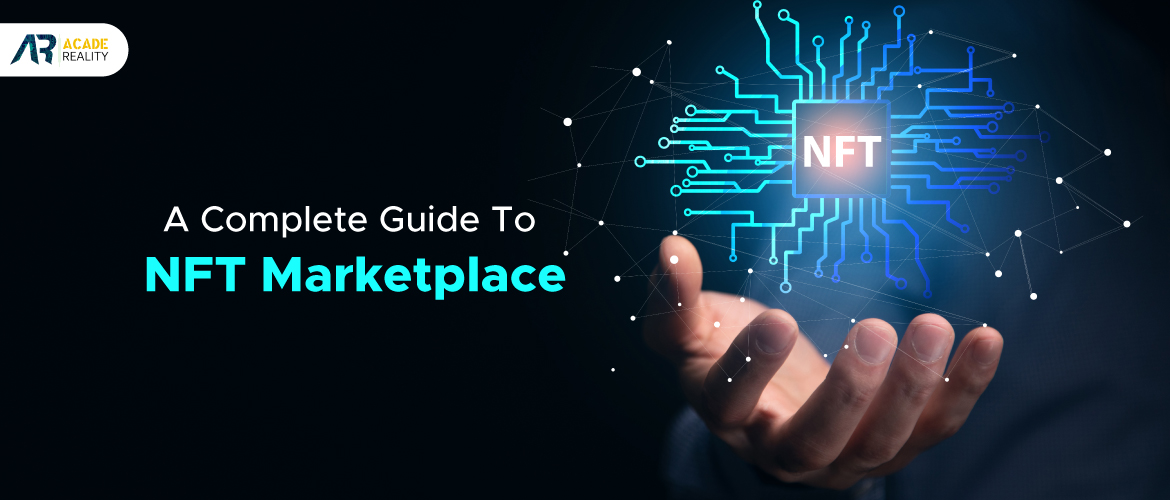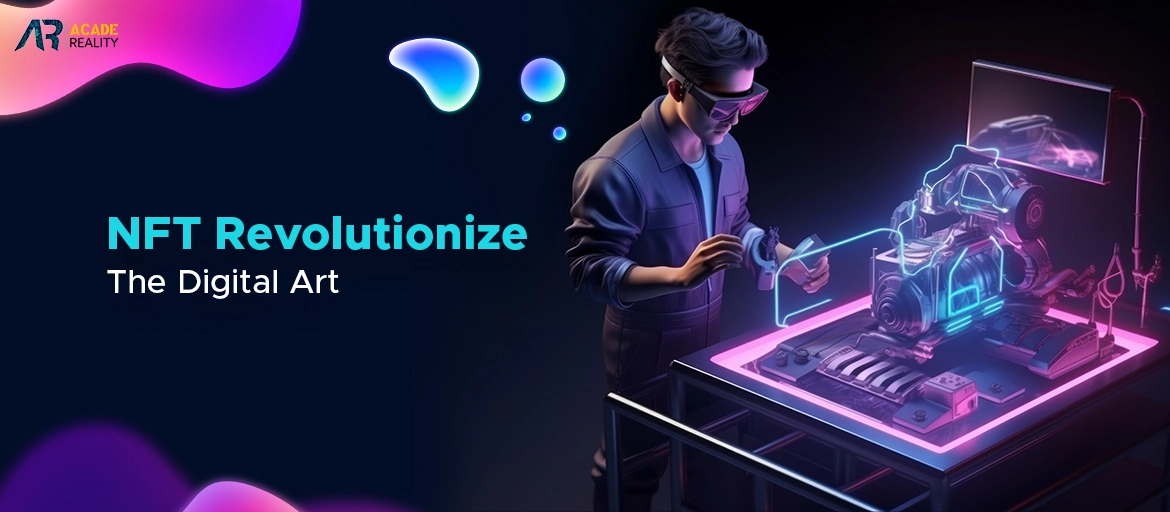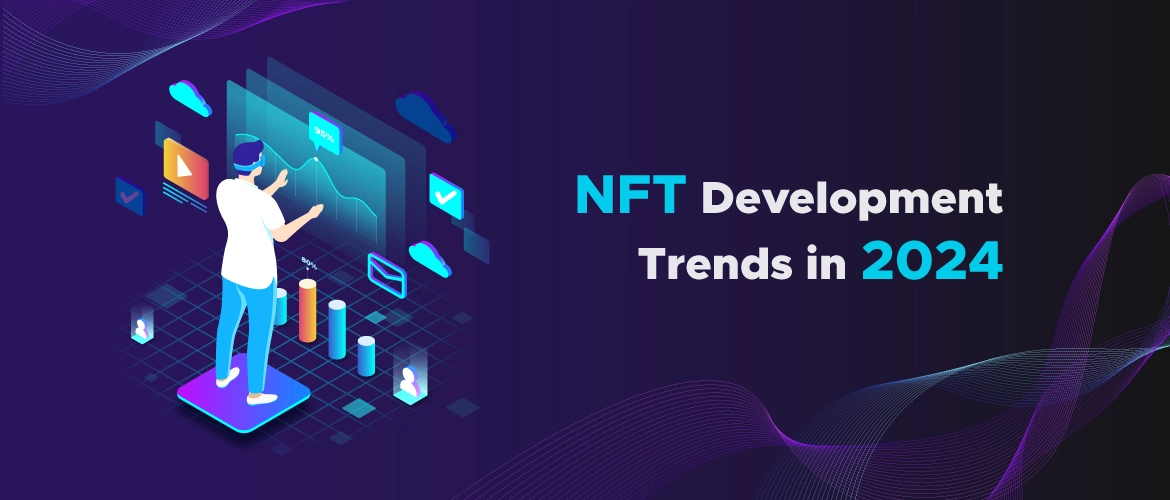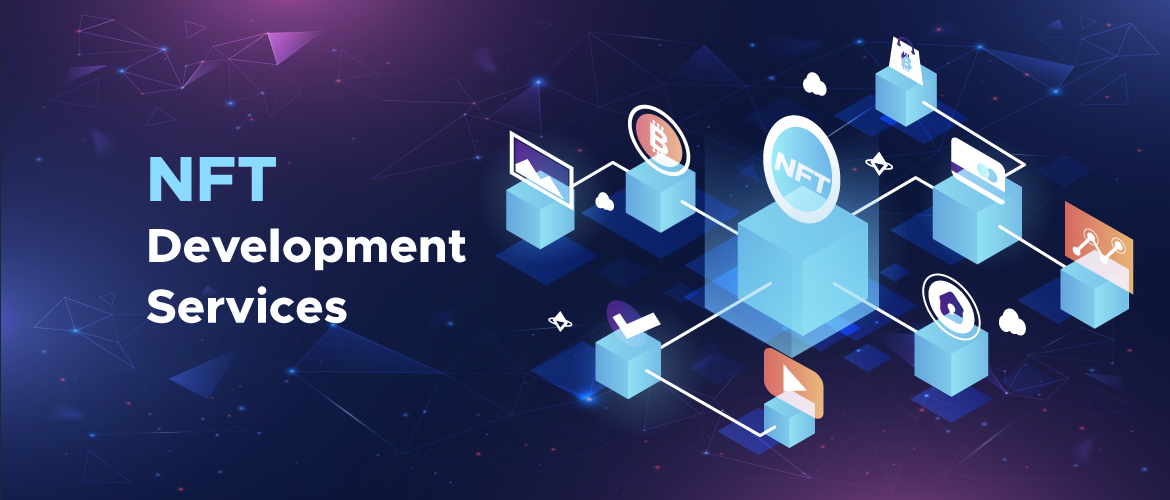A Complete Guide To NFT Marketplace

Non-Fungible Tokens (NFTs) have completely taken over the digital world, offering unique ownership and authenticity of digital assets. NFTs are indivisible and distinguishable digital assets that are stored on blockchain technology. This ensures their scarcity and uniqueness, making them ideal for representing ownership in the digital realm.
To participate in this transformative landscape, it's essential to understand the key component: NFT marketplaces. In this guide, we will explore what is NFT marketplace, how it works, the types of NFT development services available, the must-have features of a successful NFT marketplace, factors that characterize NFT marketplace, and how to build your very own NFT marketplace.
NFTs have received a lot of interest because of their applications in art, music, gaming, and virtual real estate, among others. However, to trade NFTs effectively, one needs access to NFT marketplaces, which serve as the primary platforms for buying, selling, and trading these unique digital assets.
What is NFT Marketplace?
An online marketplace for NFT transactions facilitates the creation, listing, buying, and selling of NFTs. It acts as a digital marketplace where creators can tokenize their digital assets, collectors can purchase NFTs, and investors can speculate on the value of these digital collectibles.
NFT marketplaces have gained immense popularity due to their user-friendly interfaces and secure blockchain technology. These platforms enable creators to monetize their digital creations and allow collectors to own unique, verifiable digital assets.
Types of NFT Development Services
Before delving into the workings of an NFT marketplace, it's crucial to understand the different types of NFT available. These services are essential for building and maintaining a successful NFT marketplace.
The following are some essential NFT development services features:
1. NFT Smart Contract Development
NFT smart contracts are the backbone of any NFT marketplace. They define the rules for creating, transferring, and trading NFTs. It can help you design and deploy these smart contracts on a blockchain network, ensuring secure and transparent transactions.
2. User Experience(UX) and User Interface(UI) Design
An intuitive and visually appealing UI/UX design is essential for attracting users to your NFT marketplace. It can assist in creating a user-friendly platform that encourages engagement and transactions.
3. Wallet Integration
NFT marketplaces require wallet integration to facilitate transactions. It can help you integrate different types of wallets, such as Metamask or Trust Wallet, to ensure a seamless user experience.
4. Blockchain Integration
Choosing the right blockchain network is crucial for your NFT marketplace. Ethereum is the most popular choice, but other networks like Binance Smart Chain and Flow are gaining traction. It can help you select the most suitable blockchain and integrate it into your platform.
5. Security and Auditing
Security is paramount in the NFT space, as users trust these platforms with valuable digital assets. It conducts security audits and implements robust security measures to protect user data and assets.
How Does an NFT Marketplace Work?
Understanding the mechanics of an NFT marketplace is essential for both creators and collectors.
Here's a step-by-step overview of how an NFT marketplace operates:
1.Asset Tokenization
Creators upload their digital assets to the NFT marketplace. These resources may include digital artwork, audio, or videos, virtual real estate, or any unique digital item. The NFT marketplace then converts these assets into non-fungible tokens using smart contracts.
2. Listing and Auction
Once tokenized, creators can list their NFTs for sale. They can choose to sell them through various methods, including fixed-price listings, timed auctions, or reserve-price auctions. Collectors can browse these listings and place bids or purchase NFTs directly.
3. Ownership Verification
Every NFT on the marketplace has a unique token ID, which is stored on the blockchain. This ID serves as proof of ownership and authenticity. Buyers can verify the ownership and provenance of an NFT by checking the blockchain records.
4. Transfers and Resales
NFTs are transferable, allowing buyers to sell or trade them on the same or other NFT marketplaces. The blockchain keeps track of every transfer, ensuring a transparent and immutable transaction history.
5. Royalties and Smart Contracts
One unique feature of NFTs is the ability to include royalties in smart contracts. Creators can earn a percentage of every resale of their NFT, providing ongoing revenue for their work.
6. Wallet Integration
Users need a compatible digital wallet to interact with the NFT marketplace. They can connect their wallets to the platform to manage their NFT collections, make purchases, and transfer assets securely.
Must-Have Features in an NFT Marketplace
Creating a successful NFT marketplace requires careful planning and the inclusion of essential features to attract and retain users. Here are some must-have features for your NFT marketplace:
- User-friendly Interface: A clean and intuitive UI/UX design is critical to ensure a positive user experience. Make it easy for users to navigate, search for NFTs, and manage their collections.
- Robust Search and Discovery: Implement advanced search and filtering options to help users discover NFTs based on criteria like category, price range, creator, and rarity.
- Wallet Integration: Ensure compatibility with popular digital wallets to facilitate seamless transactions and asset management.
- Smart Contracts and Security: Implement secure smart contracts to protect users' assets and data. Security audits are necessary to find and fix vulnerabilities on a regular basis.
- Gas Fee Management: Consider implementing solutions to mitigate high gas fees, which can be a barrier to entry for users.
- Community and Social Features: Include functions that enable users to communicate with creators and fellow collectors, fostering a sense of community.
- Analytics and Insights: Provide users with data on the performance of their NFTs, including transaction history, price trends, and resale values.
How to Build an NFT Marketplace
Building an NFT marketplace involves several steps, from conceptualization to launch. Here's a simplified roadmap:
- Market Research: Understand the niche you want to target and carry out extensive market research to find possibilities and competition.
- Select the Blockchain: Choose the blockchain network that aligns with your project's goals and requirements. Ethereum is the most popular choice, but consider alternatives based on scalability and cost.
- NFT Smart Contract Development: Work with NFT development services to design and deploy smart contracts that govern your NFT marketplace's operations.
- UI/UX Design: Collaborate with designers to create an appealing and user-friendly interface for your platform.
- Wallet Integration: Integrate digital wallets to enable users to interact with your marketplace securely.
- Security Measures: To maintain the security of user assets and data, implement strong security measures and perform audits.
- Marketing and Promotion: Plan your promotion to draw makers and collectors to your platform. Consider partnerships, social media, and community engagement.
- Launch and Maintenance: Launch your NFT marketplace and continuously monitor and improve it based on user feedback and market trends.
Factors that Characterize Non-Fungible Token Marketplace
There are several key factors that characterize NFT marketplaces and contribute to their success and functionality.
Here are some key factors that characterize NFT Marketplace:
1. Digital Ownership and Authenticity
The use of blockchain technology in NFT marketplaces ensures
digital ownership and authenticity. Each NFT is represented as a unique, indivisible token on the blockchain, making it impossible to duplicate or counterfeit. This feature is a game-changer for artists, creators, and collectors, as it provides irrefutable proof of ownership and provenance for digital assets.
2. Interoperability
NFT marketplaces often support multiple blockchain networks, enabling interoperability between different ecosystems. While Ethereum remains the dominant blockchain for NFTs, other networks like Binance Smart Chain and Flow have also gained traction. Interoperability allows NFT collectors and creators to choose the blockchain that suits their needs and preferences.
3. Ownership and Royalties
One of the unique aspects of NFTs is the ability to embed royalties in smart contracts. Creators can specify a percentage of the resale price that they will receive whenever the NFT changes hands. This feature incentivizes artists and content creators to participate in the NFT marketplace and continue producing valuable digital content.
4. Transparency and Immutability
Blockchain technology offers transparency and immutability, ensuring that all NFT transactions are recorded on a public ledger. This transparency builds trust among users, as they can verify the ownership history and authenticity of NFTs. A transaction that has been recorded on the blockchain cannot be changed or removed, adding a layer of security and trust to NFT marketplaces.
5. Decentralization
NFT marketplaces are often decentralized, meaning they operate without a central authority or intermediary. This decentralized nature aligns with the principles of blockchain technology, reducing the risk of censorship, fraud, or third-party control. Decentralized NFT marketplaces provide users with greater control over their digital assets.
6. User-Friendly Interfaces
Successful NFT marketplaces prioritize user-friendly interfaces and experiences. They invest in intuitive designs and navigation to ensure that both creators and collectors can easily list, browse, purchase, and manage NFTs. An attractive and user-centric design can significantly impact the adoption and retention of users on these platforms.
7. Community and Social Engagement
Successful NFT marketplaces foster communities where creators and collectors can interact, collaborate, and share their passion for digital art and collectibles. Social media integration, chat rooms, and forum features enhance the sense of belonging and engagement within the platform.
8. Curation and Discovery
To help users discover NFTs of interest, marketplaces often implement curation mechanisms and recommendation algorithms. This ensures that valuable NFTs receive visibility and that collectors can easily find items that match their preferences.
Conclusion
The world of NFT marketplaces is dynamic and full of opportunities. As the demand for unique digital assets continues to grow, understanding how these platforms work and how to build one is essential. Whether you're an artist looking to monetize your creations or an entrepreneur seeking to enter the NFT space, this guide provides a comprehensive overview to get you started.
Remember that success in the NFT marketplace requires a combination of technology, creativity, and a deep understanding of your target audience. By remaining knowledgeable and adjusting to the changing environment, you can thrive in this exciting and innovative digital ecosystem.
You Might Like



